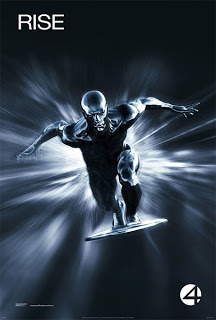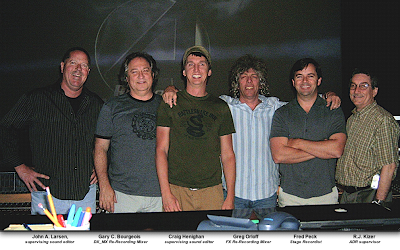 “Fantastic Four 2: Rise of the Silver Surfer” lands into theaters June 15th. This the second Marvel sequel this year guarantees loads of aural opportunity with its metallic beach bum villain. Craig Henighan and John A. Larsen co-supervised the show with the bulk of the sound editorial being done on the Fox lot. Henighan and Larsen have been working together since last year’s “X-Men 3 “. Mixing took place on Sony’s William Holden dub stage, with Gary C. Bourgeois and Greg Orloff as DX/MX and FX mixers, respectively. This is their second marvel film of the year, hot off the heals of February’s “Ghost Rider”. Eric Batut, coming off last winter’s “Eragon,” shot production sound. John Ottman, also a returning craftsman from “Fantastic Four” (Larsen and Batut also worked on it) scored the film. the perennial multitasker, Ottman both cut and scored last year’s “Superman Returns.”
“Fantastic Four 2: Rise of the Silver Surfer” lands into theaters June 15th. This the second Marvel sequel this year guarantees loads of aural opportunity with its metallic beach bum villain. Craig Henighan and John A. Larsen co-supervised the show with the bulk of the sound editorial being done on the Fox lot. Henighan and Larsen have been working together since last year’s “X-Men 3 “. Mixing took place on Sony’s William Holden dub stage, with Gary C. Bourgeois and Greg Orloff as DX/MX and FX mixers, respectively. This is their second marvel film of the year, hot off the heals of February’s “Ghost Rider”. Eric Batut, coming off last winter’s “Eragon,” shot production sound. John Ottman, also a returning craftsman from “Fantastic Four” (Larsen and Batut also worked on it) scored the film. the perennial multitasker, Ottman both cut and scored last year’s “Superman Returns.”
Thanks to Craig Henighan who took time out of a busy dub schedule to participate in a brief Q and A:
Designing Sound: With so many characters with unique super powers, which was your favorite to design sound for?
Craig Henighan: The most interesting character to design was Silver Surfer. He had to be graceful, sleek, stealthy, but also capable of showing immense speed and power. I started with basic recordings of thin sheet metal with contact mics placed on both sides of the metal. I then put some thick oil on the metal and performed movement to some of the earliest sequences I received from the pix editors. From that I built specific moves for Surfer. Hovering, slow moves and fast -bys were accomplished by layering different pitches of the sound. I also used GRM tools doppler plug-ins to get even more movement from the performances. I then had [foley artist] Dan O’Connell do some wild recordings of anything that came to his mind for the Silver Surfer. He did some interesting stuff, so I would take bits and pieces of what he did and incorporate them into the sounds for specific moments.
I also built a library of “breath-bys”, which came from conversations with Director Tim Story, who wanted to have Surfer be graceful in spots. I ended up recording my own voice, added some chorus and tremolo, then once again set about pitching and layering to get the required feeling I was after. As for the other characters, my job was to take their signature sounds and further refine them. I didn’t work on the first “Fantastic Four,” so I first listened to all the original sound elements for the given characters, then built upon them, making some stronger, (Johnny’s flames) and some more precise (Dr Doom’s power blasts).
DS: How much field recording did you get to do?
CH: We recorded four cars for the “Fantastic Car”, which makes its debut in this film. We did a Dodge Viper, Dodge Hemi Charger, and two Ford Mustangs. Rob Nokes, from Sounddogs.com came out and helped us with his deva. We did a day at a drag strip and another night session out in Palmdale. We used Rob’s 8 channel Deva, plus two Sound Devices 744’s. I also did a bunch of smaller recordings for things such as Reed’s stretching, Johnny’s flames, the Silver Surfer’s board going through walls and windows. Everything from liquid, to smooth glass elements, to flares, etc.
DS: Did you and John Larsen get a chance to communicate with John Ottman during editorial about score and FX correlation?
CH: John Ottman and I started sending mini mixes back and forth in late January. We had a few discussions of what tonal stuff I was doing and how it would play against his music. For the most part, everything has its place; he really knows how to score around big action moments, so it gives my stuff a chance to breathe. The track has great clarity to it.
DS: With large shows like this, how important is premixing units, before hitting the predub stage?
CH: We spent about three weeks premixing my tracks from the ground up. I normally do a lot of premixing in my suite and deliver 5.1’s, 5.0’s and LCR’s. This time I thought it’d be fun to deconstruct what I did in my room and reinterpret it at the premix stage. Greg Orloff and I had a lot of fun. We did a lot of work prior to the final mix. Most of the VFX didn’t show up until the final, which made it interesting at times because some of the visuals changed quite dramatically.
